To accelerate healing by up to 80%, select wavelengths between 630-850nm based on your condition. Use 630-660nm for skin-level healing and 808-830nm for deeper tissue repair. Schedule 10-20 minute sessions 3-5 times weekly, staying 6-12 inches from the light source. Combine multiple wavelengths like 660nm and 808nm for enhanced results across different tissue depths. Track your progress with photos and measurements while monitoring skin temperature during sessions. Keep sessions consistent but allow recovery time between treatments. Don't exceed twice-daily sessions, and adjust power settings based on your specific needs. Discover how these wavelength combinations can transform your healing journey.
Select Your Healing Wavelength Wisely
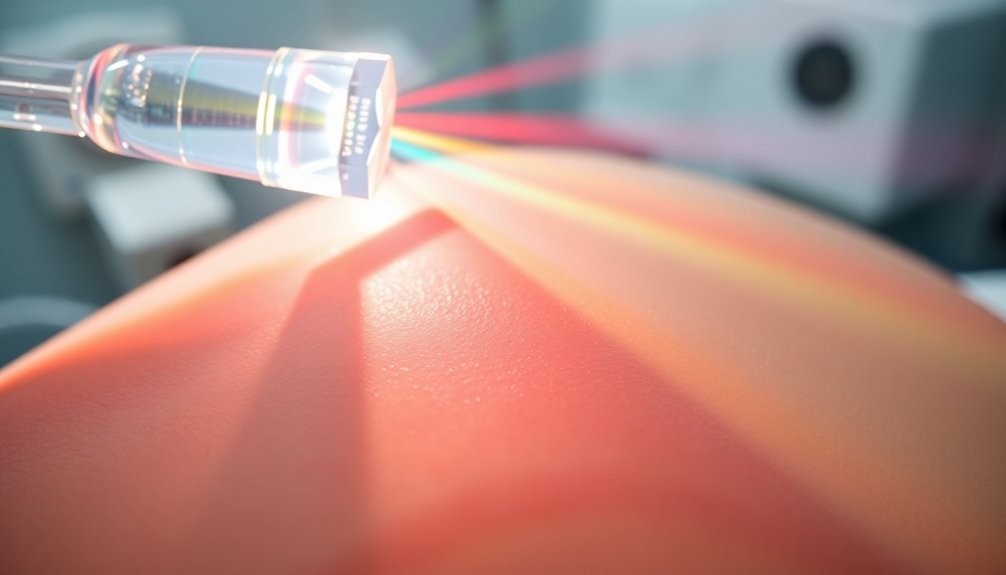
When it comes to healing with light therapy, selecting the right wavelength can make all the difference in your treatment's success. You'll need to match the wavelength to your specific healing needs, taking into account factors like tissue depth and the type of condition you're treating.
For deeper tissue healing and regeneration, you'll want to evaluate near-infrared wavelengths like 830nm or 808nm. These wavelengths penetrate deeper into your tissues and are particularly effective for treating musculoskeletal conditions, arthritis, and surgical wounds. For the most advanced clinical treatments, consider that 808nm wavelengths are often preferred due to their superior therapeutic outcomes.
If you're dealing with osteoarthritis or deep tissue damage, the 808nm wavelength should be your go-to choice.
However, if you're focusing on skin-deep conditions or ATP production, the 660nm red light wavelength might serve you better. It's proven more effective at increasing ATP production compared to 830nm.
You can also combine different wavelengths to treat larger tissue volumes and address multiple concerns simultaneously.
Remember that penetration depth varies substantially between wavelengths. Near-infrared light reaches deeper tissues than visible light, so you'll need to adjust your treatment approach based on where your target tissue is located.
Deep Tissue Healing With 808nm
The power of 808nm wavelength light therapy lies in its exceptional ability to penetrate deep tissue layers. When you're dealing with conditions like osteoarthritis, tendon injuries, or joint pain, you'll want this deeper penetration to effectively target the affected areas. The biphasic dose response means that too much exposure can actually reduce healing benefits.
Studies show that 808nm light therapy is up to 60% more effective than 850nm for deep tissue healing.
You'll notice significant benefits when using 808nm wavelength therapy, particularly in:
- Enhanced cellular regeneration at deeper tissue layers
- Accelerated healing of surgical wounds and injuries
- Improved athletic performance and exercise recovery
- Reduced inflammation in joints and tendons
- Increased collagen production for faster tissue repair
While 850nm wavelength is more widely available and cost-effective, it won't match the therapeutic impact of 808nm for serious conditions requiring deep tissue penetration. If you're considering combination therapy, you can use 808nm for deeper issues while utilizing 850nm for superficial healing. Remember to adjust your dosage based on the specific condition you're treating, as proper energy density and irradiance are vital for achieving the best results.
Timing Your Light Therapy Sessions
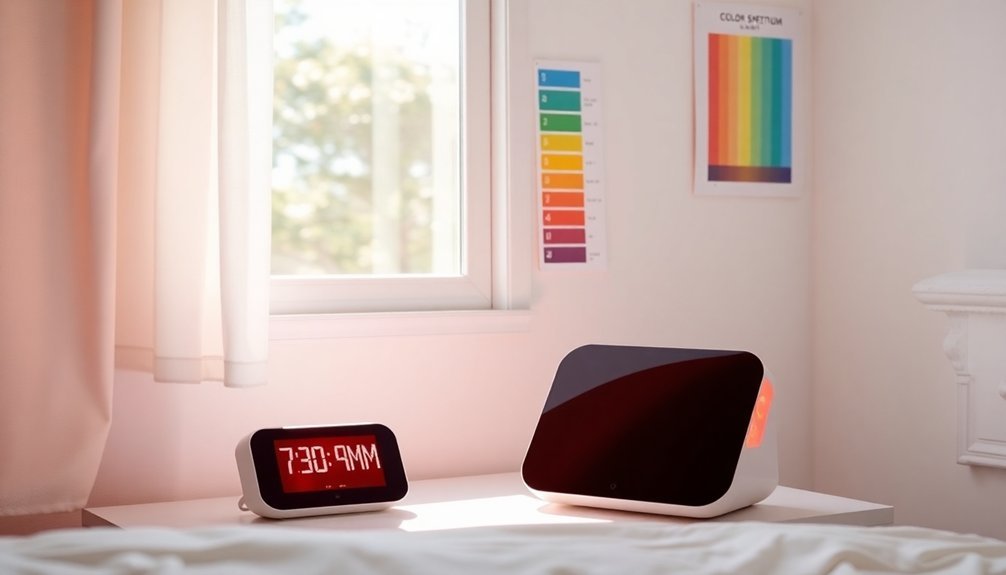
Success in light therapy depends heavily on proper timing and consistency of your sessions. You'll need to dedicate 10-20 minutes per session, 3-5 times weekly for most conditions. Stand 10-15 cm from the light source, and you can schedule sessions any time of day – morning treatments energize while evening sessions promote relaxation. For optimal absorption, ensure to maintain a closer distance when treating deeper tissues.
Your specific condition determines the best timing pattern. For faster healing, follow these evidence-based durations:
| Condition | Recommended Timing |
|---|---|
| Skin Rejuvenation | 10-20 min, 3-5x weekly |
| Muscle Recovery | 15-20 min, 3-5x weekly |
| Wound Healing | 10-15 min, daily/alt. days |
| Chronic Issues | 15-20 min, 4-5x weekly |
| Mental Health | 10-20 min, 3-4x weekly |
If you're new to light therapy, start with shorter 5-10 minute sessions and gradually increase duration. Consider your age and treatment area – thinner skin needs less time (5-10 minutes), while thicker areas require 15-30 minutes. Don't take sessions twice daily, and always follow your healthcare provider's specific guidelines if prescribed. You can multitask during sessions, but maintaining consistency is key for ideal results.
Maximizing 830nm Benefits
Building on your understanding of light therapy timing, proper wavelength selection plays a major role in treatment outcomes. When using 830nm light therapy, you'll find it offers exceptional penetration depth and therapeutic benefits, particularly for deep tissue healing and systemic effects.
You can maximize 830nm benefits through strategic application for various conditions:
- Imagine the light penetrating deep into your joints, reducing inflammation and easing arthritic pain
- Picture increased blood flow throughout your treatment area as nitric oxide release stimulates circulation
- Visualize accelerated wound healing as cellular activity and collagen production increase
- See damaged muscle tissue repairing itself more efficiently after exercise
- Envision the light reaching deep into tissues, promoting healing from the inside out
Clinical evidence strongly supports 830nm's effectiveness for wound healing, tissue repair, and inflammation reduction. Users have reported an 80% reduction in pain within 1-4 weeks of consistent treatment.
You'll get ideal results using non-contact devices like LED panels, which provide homogeneous illumination across the treatment area. For deep tissue conditions, 830nm's superior penetration makes it particularly effective, especially when treating musculoskeletal injuries or conducting transcranial photobiomodulation for brain health benefits.
Combining Multiple Wavelengths
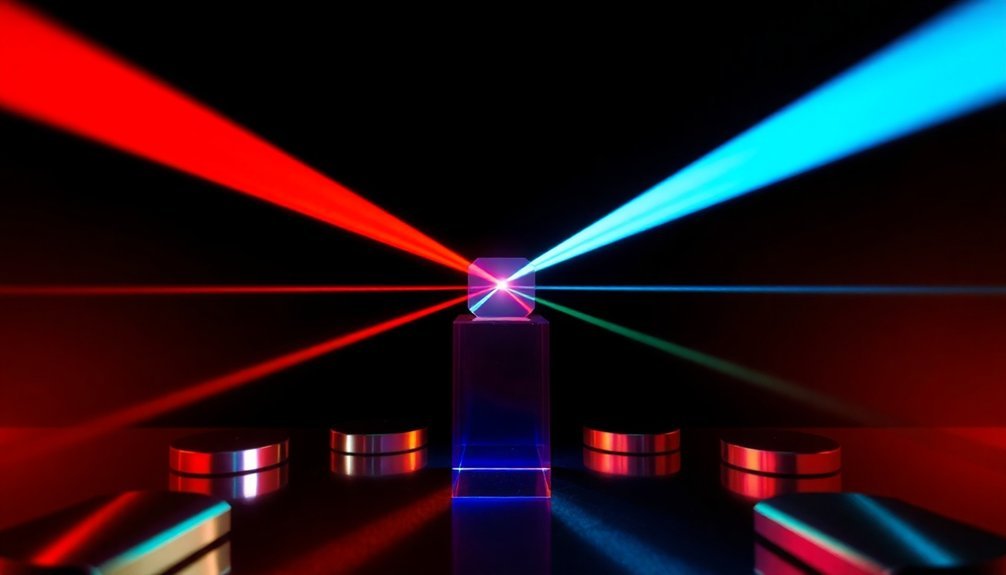
While single wavelengths offer significant benefits, combining multiple wavelengths in your light therapy sessions can dramatically enhance treatment outcomes through synergistic effects. You'll see improved results when pairing wavelengths like 633nm and 830nm for skin health, or 660nm and 808nm for accelerated wound healing. These combinations target different tissue depths simultaneously, activating multiple biological pathways.
| Wavelength Combo | Primary Benefits | Best For |
|---|---|---|
| 633nm + 830nm | Improved elasticity, reduced melanin | Skin health |
| 635nm + 808nm | Enhanced nitric oxide production | Circulation |
| 670nm + 810nm | Better cognitive function | Brain health |
| 660nm + 808nm | Accelerated tissue repair | Wound healing |
When you're using multi-wavelength therapy, you'll want to take into account the penetration depth of each wavelength. Near-infrared light reaches deeper tissues, while red light works more effectively on surface-level concerns. The combination guarantees you're getting thorough coverage throughout the treatment area. For whole-body benefits, multi-wavelength devices provide more uniform cell activation and can address multiple conditions simultaneously. You'll need to adjust treatment times and intensities based on the specific wavelength combination you're using.
Treatment Distance Matters
Distance plays a crucial role in maximizing the effectiveness of your light therapy treatments. When you're using red light therapy devices, following the manufacturer's recommended distance guidelines guarantees you'll achieve the best results and maintain safety standards.
The intensity of light follows the inverse square law, meaning it decreases substantially as you move further from the source. Using wavelengths between 630 and 700 nanometers ensures optimal penetration at the correct distance.
To help you visualize proper treatment distance setup, consider these key points:
- Position your device at eye level when treating facial areas
- Use a measuring tape to confirm the exact recommended distance
- Keep the device perpendicular to the treatment area
- Maintain consistent distance throughout the session
- Check for any heat sensation to adjust positioning
You'll need to pay close attention to your device's specific instructions, as the best treatment distances vary between different models and power outputs. Getting too close can potentially cause discomfort or reduced effectiveness, while being too far away might result in insufficient light intensity reaching your target area.
Remember that precision in distance control helps guarantee you're receiving the intended therapeutic benefits from each session. Always monitor your comfort level and adjust accordingly while staying within the recommended range.
Track Your Healing Progress
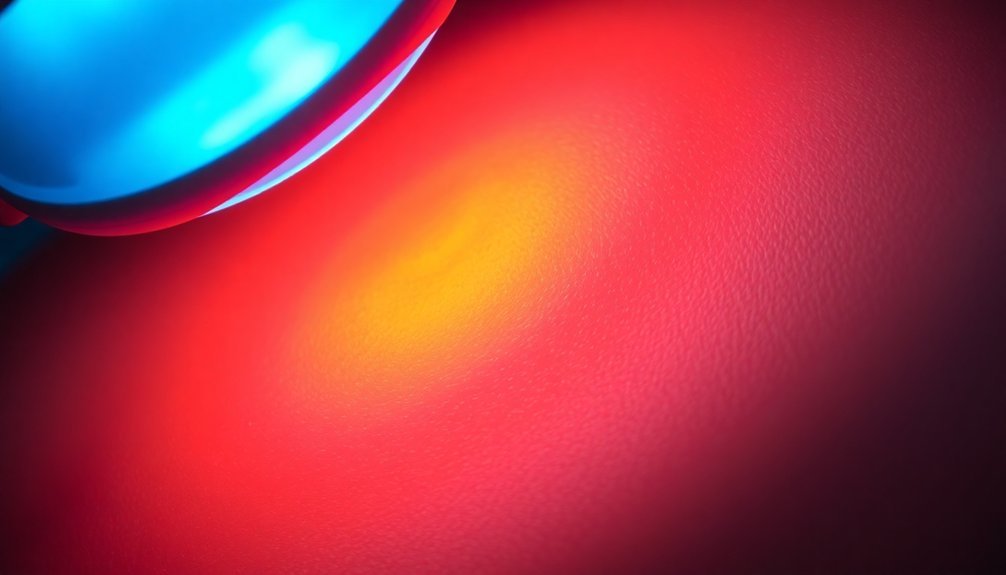
Tracking your healing progress through weekly measurements lets you monitor recovery gains and adjust treatments as needed. Breaking down data into organized measurements helps ensure you capture all relevant healing metrics systematically. You'll want to document changes in healing time between sessions to identify which wavelengths work best for your condition. Compare results across different treatment zones to understand how specific areas respond to the wavelength therapy and optimize your healing protocol accordingly.
Measure Weekly Recovery Gains
A successful healing journey relies on measuring and monitoring your progress consistently. By tracking your weekly recovery gains, you'll gain valuable insights into your healing trajectory and maintain motivation throughout the process. Using standardized tools like the Barber Measuring Tool helps you calculate healing percentages and monitor wound volume changes accurately.
Your weekly measurements should include:
- Visual documentation through consistent photographs
- Precise wound volume calculations
- Physical measurements of wound margins
- Notes on tissue color and appearance
- Records of any symptoms or changes
Don't let the challenges of tracking progress discourage you. While wounds can take substantial time to heal, regular monitoring empowers you to take control of your recovery journey.
Set measurable goals and use digital platforms to simplify your tracking process. This systematic approach allows you to recognize patterns, celebrate improvements, and make necessary adjustments to your treatment plan.
Remember that consistent tracking provides valuable data for your healthcare providers, enabling them to assess treatment effectiveness and make informed decisions about your care.
You'll find that visualizing your progress helps maintain hope and reinforces your commitment to the healing process.
Document Healing Time Changes
Through consistent documentation of your healing journey, you'll gain valuable insights into recovery patterns and treatment effectiveness. By tracking changes in your wound dimensions and healing progress over time, you can better understand if treatments are working as expected and identify any deviations that need attention.
Take advantage of modern digital tools to streamline your documentation process. The Barber Measuring Tool offers graphical representations of your healing progression, while various apps and electronic health records help you maintain organized, accessible data.
These platforms make it easier to spot trends and compare healing rates across different treatment phases.
When documenting your progress, focus on dimensional assessments that measure wound size and volume. Keep in mind that healing trajectories can vary substantially, so don't get discouraged by temporary plateaus or slower periods.
Your documentation will help healthcare providers make more informed decisions about your treatment plan and adjust interventions as needed.
Remember to maintain consistent tracking intervals, typically weekly, to build a reliable record of your recovery. This systematic approach will provide objective evidence of your healing progress and help determine the effectiveness of your current treatment protocol.
Compare Treatment Zone Results
For effective healing assessment, comparing treatment zone results requires systematic monitoring across different areas of the wound. You'll need to track multiple aspects of healing simultaneously using both visual and measurable indicators to determine which treatment zones are responding best.
Document your observations across different treatment areas with these key comparison points:
- Changes in wound dimensions, including depth and perimeter measurements for each zone
- Formation of new granulation tissue and its color variations between treatment areas
- Temperature differences across zones that might indicate varying levels of blood flow
- Signs of infection or inflammation specific to certain treatment areas
- Rate of scar tissue development and its elasticity in different zones
The wound healing process transitions through multiple healing phases that require different monitoring approaches during each stage. You can enhance your tracking by using digital tools to record and analyze the data. The Barber Measuring Tool and other computerized platforms will help you create standardized measurements for accurate zone comparisons.
Make sure you're taking regular photographs of each treatment area to document visual changes over time. By maintaining consistent assessment intervals and using the same measurement techniques across all zones, you'll be able to identify which treatments are producing the best healing outcomes.
Wavelength Power and Duration
Power settings and treatment duration play pivotal roles in the effectiveness of wavelength therapy. When you're using light therapy devices, you'll need to carefully think about both factors to achieve the best results while avoiding potential tissue damage.
Higher power settings can penetrate deeper into your tissues, but they also increase the risk of overheating, requiring careful monitoring during treatment. Research shows that red and NIR wavelengths are most effective for therapeutic applications.
You'll find that there's no universal formula for power and duration settings, as these depend heavily on your specific condition and treatment goals. If you're treating surface-level concerns like acne or skin rejuvenation using 630-680 nm wavelengths, you'll likely need different power settings than when targeting deeper issues like arthritis with 800-1000 nm wavelengths.
While many devices come with pre-programmed settings for various conditions, it's best to seek professional guidance for your specific situation.
When selecting your treatment parameters, you'll want to think about factors like your skin type, the depth of the tissue you're targeting, and any underlying health conditions. Remember that longer wavelengths typically require different power settings than shorter ones due to their deeper penetration capabilities.
Monitor Skin Temperature
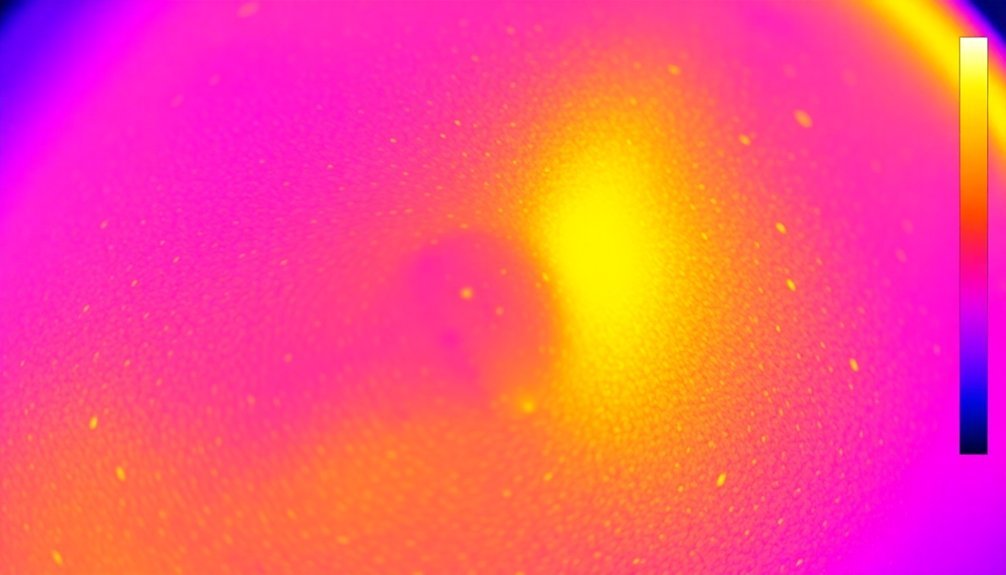
While monitoring your wavelength treatments, you'll need to track how heat distributes across your skin's surface to guarantee even healing.
Your skin temperature should stay within 91.4 to 107.6 degrees Fahrenheit during treatment sessions, as this range promotes ideal cellular activity and healing processes.
You can use thermal imaging or temperature sensors to confirm you're maintaining safe levels and achieving consistent heat distribution throughout the treatment area.
Heat Distribution While Healing
The human body's healing process relies heavily on maintaining the right temperature, with even a slight 2°C drop potentially halting tissue repair. Your body functions ideally at 37°C (98.6°F), and when tissue cools, blood vessels constrict, making it harder for oxygen to reach the healing area.
Once disrupted, it can take up to 4 hours for a wound to return to its normal healing temperature.
You'll find various methods to monitor skin temperature during healing:
- Wireless sensor dressings that continuously track wound conditions
- Infrared thermal cameras that measure temperature without contact
- Thermistors providing direct temperature readings
- Capacitive sensors detecting skin hydration levels
- Open-chamber devices measuring moisture loss
To maintain ideal healing temperatures, you'll want to choose the right dressing. Polyurethane foam dressings offer superior insulation compared to traditional gauze or film dressings. Don't change dressings too frequently, as this disrupts the thermal environment.
Remember that elevated skin temperatures can persist for up to an hour after pressure relief, and continuous high temperatures might indicate infection or excessive inflammation.
Safe Temperature Ranges
Maintaining safe temperature ranges during wound healing requires careful monitoring and specific parameters. You'll need to keep the wound bed temperature between 30.2-33.0°C while ensuring the surrounding skin doesn't exceed 43-44°C during heat therapy.
Your body's core temperature should stay above 91.4°F and below 107.6°F for ideal healing.
When you're monitoring wound temperatures, watch for thermal gradients that could indicate infection. If you notice a temperature difference greater than +3°C compared to surrounding tissue, it may signal an infection. As healing progresses, this gradient should decrease to less than +2°C.
You'll want to maintain consistent temperature levels, as even a 2°C drop can disrupt healing processes.
During dressing changes, remember that wound temperature can decrease for up to 4 hours, affecting cellular activity. If you're applying cold therapy, limit sessions to 30 minutes to prevent tissue damage. For heat applications, stay within 40-45°C (104-113.9°F).
You should regularly check your skin's response and avoid loose dressings that can cause heat loss. Watch for signs of vasodilation or vasoconstriction during any temperature-based therapy.
Recovery Between Light Sessions
Between healing sessions with red light therapy, proper recovery timing plays a critical role in achieving best results. You'll need to wait at least 6 hours between sessions to prevent overexposure and maintain effectiveness.
For ideal healing, aim to use red light therapy 2-3 times per week, with sessions lasting 10-30 minutes depending on your specific needs and treatment areas.
When incorporating red light therapy into your routine, you can maximize its benefits through strategic timing. Using it before exercise helps prevent muscle damage, while post-workout sessions accelerate recovery and reduce inflammation.
You'll typically see full benefits develop over several weeks to months of consistent use.
Consider these key recovery indicators to track your progress:
- Reduced muscle soreness after workouts
- Improved muscle strength and endurance
- Enhanced blood flow to treated areas
- Faster healing of acute inflammations
- Better overall muscle function and performance
Your recovery process benefits from red light therapy's ability to boost ATP energy synthesis, improve glycogen production, and enhance oxygen availability in muscle tissue. Remember, consistency in your treatment schedule is essential for achieving long-term healing benefits.
Frequently Asked Questions
Can Red Light Therapy Interact With Medications or Supplements?
Yes, you'll need caution as red light therapy can interact with certain medications, especially photosensitizing drugs. You should always consult your healthcare provider before starting treatment if you're taking any medications.
Is Red Light Therapy Safe During Pregnancy?
While red light therapy is generally considered safe during pregnancy, you'll want to avoid direct abdominal exposure and consult your healthcare provider first. Stick to treating other body areas and follow proper safety guidelines.
How Long Do Healing Benefits Last After Each Treatment Session?
You'll notice immediate benefits right after treatment that can last several days. For sustained results, you'll need regular sessions. Without maintenance treatments, the healing effects will gradually diminish over time.
Should I Wear Sunscreen During Red Light Therapy Sessions?
You don't need to remove sunscreen during red light therapy. While it's best to apply sunscreen after your session, the wavelengths will still penetrate effectively even if you're wearing it during treatment.
Can Children Safely Undergo Red Light Therapy Treatments?
Yes, children can safely undergo red light therapy when properly supervised by healthcare providers. You'll need to use FDA-approved devices, guarantee shorter sessions, provide eye protection, and monitor your child for any reactions.
In Summary
You've now got the key wavelength strategies to accelerate your healing journey. Remember, selecting the right wavelength, timing your sessions properly, and monitoring your progress will make all the difference. Don't forget to let your body rest between treatments and always pay attention to your skin's response. With these tips, you'll maximize the benefits of light therapy and achieve faster healing results.

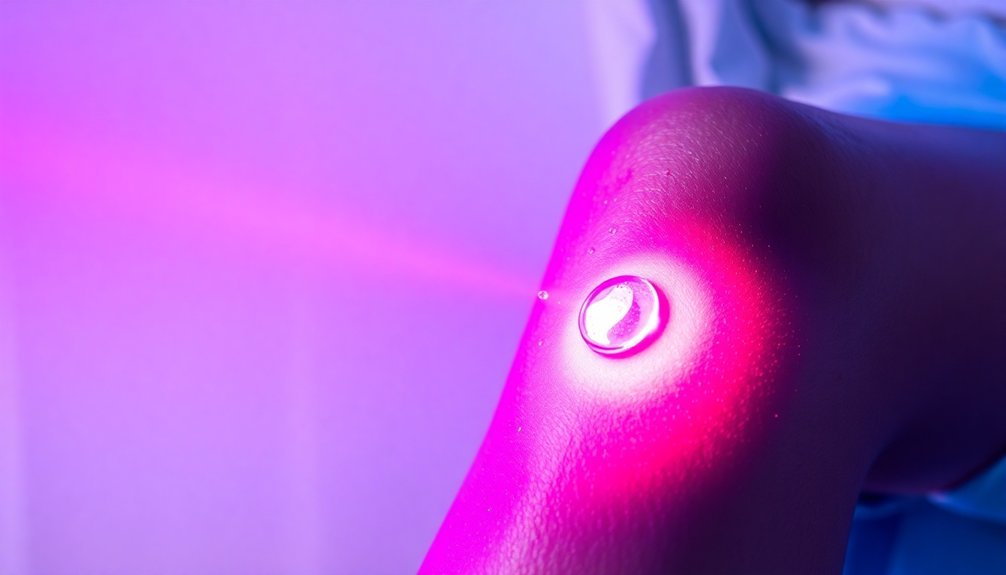



Leave a Reply